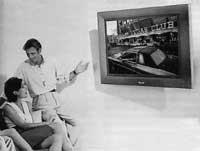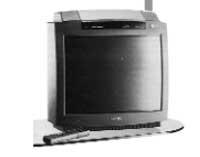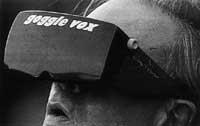Flat and thin screen
1997/03/01 Elhuyar Zientzia Iturria: Elhuyar aldizkaria
Philips, Grundig and Fujitsu, who work in the television sector, have come together to create a new screen that has resulted in a flat, thin screen called Planatron. It works in plasma and is formatted 16/9 (92 x 52 centimeters or diagonal meter). In this screen, only 10 centimeters thick, highlight the brightness and quality of the colors. It is at all better than electroluminescent and liquid crystal displays.

The surface of Planatron consists of microscopic fluorescent tubes. In each of these microlances a gas emits ultraviolet rays when the electric voltage is applied. Each lamp has a fluorescent coating that turns ultraviolet rays into visible rays. To create the three basic colors necessary to form the composite colors, some lamps have a red ray emission coating, others green emission and the rest blue color. The screen is therefore a flat mosaic of red, green and blue fluorescent lamps.
An electronic magnetoscope size box numbers the video image extracted from the magnetoscope, tunnel or any other video source and orders the on and off of fluorescent lamps, each lamp being a pixel.
They are thinking of different shapes for the entire video system around the Planatrón. Philips intends to place the screen on the wall and the electronic box on the cabinet, like any other element in the HI chain. Grundig wants to present it in a more traditional way. The screen would be on a base and the electronic box would be at the base.
The main advantages of this new plasma system are two: on the one hand, a thin screen and on the other, a very flat screen. But it also has its obstacle: the price. Its value is 1.5 million pesetas or 60,000 pounds and at the moment the cathodic tube system is expected to last several years.

Gai honi buruzko eduki gehiago
Elhuyarrek garatutako teknologia





